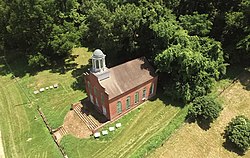Rodney, Mississippi | |
|---|---|
 Former First Presbyterian Church | |
| Nickname(s): "Petite Gulf", "Little Gulf"[1] | |
| Coordinates: 31°51′40.6″N 91°11′59.4″W / 31.861278°N 91.199833°W | |
| Country | United States |
| State | Mississippi |
| County | Jefferson |
| Founded | 1828 |
| Elevation | 82 ft (25 m) |
| Time zone | UTC-6 (Central (CST)) |
| • Summer (DST) | UTC-5 (CDT) |
| GNIS feature ID | 676809[1] |
Rodney is a ghost town in Jefferson County, Mississippi, United States.[1] Most of the buildings are gone, and the remaining structures are in various states of disrepair. The town floods regularly, and buildings have extensive flood damage. The Rodney History And Preservation Society is restoring Rodney Presbyterian Church. Damage to the church's facade from the American Civil War has been maintained as part of the historical preservation, including a replica cannonball embedded above the balcony windows. The Rodney Center Historic District is on the National Register of Historic Places.[2]
The town is approximately 32 miles (51 km) northeast of Natchez. It is currently about two miles inland from the Mississippi River. Between the town and the Mississippi are wetlands, including a lake that roughly follows the river's former course. Atop the loess bluffs behind Rodney are its cemetery and Confederate earthworks from the Civil War.

Rodney was a cultural center of the region in the early 1800s. In 1817, it was three votes away from becoming the capital of Mississippi.[3] An important hybrid strain of cotton called Petit Gulf cotton and innovations to the cotton gin were developed in Rodney by Rush Nutt. Rodney was incorporated in 1828 and became the primary port for the surrounding area, with a population in the thousands. By 1860, the town was home to a variety of businesses, multiple newspapers, and Oakland College. During the Civil War, Confederate States Army cavalry captured the crew of a Union Army ship who were attending service in Rodney Presbyterian Church, resulting in the shelling of the city. After the war, the Mississippi River changed course, the railroad bypassed the area, and nearly all buildings burned down. The population declined until the town was disincorporated in 1930.[4] By 2010, only "a hand full of people" were reported to live in Rodney.[5]
- ^ a b c U.S. Geological Survey Geographic Names Information System: Rodney. Retrieved March 4, 2024. Archived from the original.
- ^ "Rodney Center Historic District". National Park Service. Archived from the original on March 2, 2024. Retrieved March 2, 2024.
- ^ Cite error: The named reference
PBS-2013was invoked but never defined (see the help page). - ^ Logan, Mary T. (1980). Mississippi–Louisiana Border Country (Revised 2nd ed.). Baton Rouge, Louisiana: Claitor's. LCCN 70-137737.
- ^ Grayson, Walt (August 26, 2010). "Rodney Presbyterian Church". WLBT3. Archived from the original on March 10, 2016.

